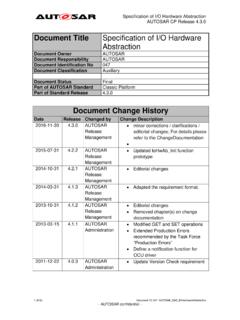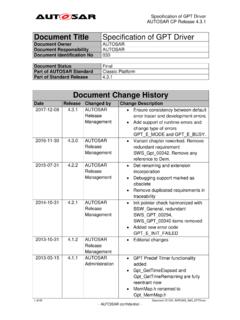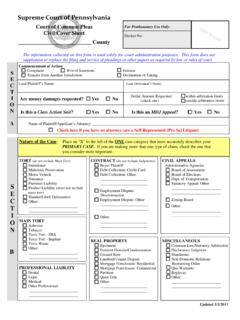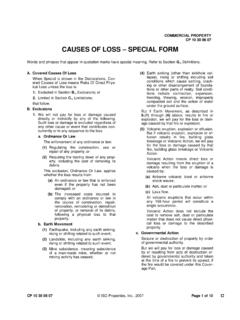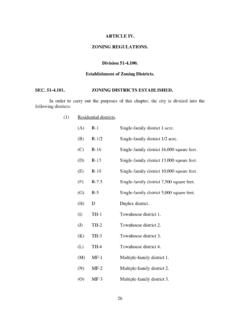Transcription of XC2C256 CoolRunner-II CPLD - Xilinx
1 DS094 ( ) March 8, Specification 2002-2007 Xilinx , Inc. All rights reserved. All Xilinx trademarks, registered trademarks, patents, and disclaimers are as listed at All other trademarks and registered trademarks are the property of their respective owners. All specifications are subject to change without Optimized for systems-As fast as ns pin-to-pin delays-As low as 13 A quiescent current Industry s best micron CMOS CPLD-Optimized architecture for effective logic synthesis. Refer to the CoolRunner -II family data sheet for architecture description. -Multi-voltage I/O operation to Available in multiple package options-100-pin VQFP with 80 user I/O-144-pin TQFP with 118 user I/O-132-ball CP ( ) BGA with 106 user I/O-208-pin PQFP with 173 user I/O-256-ball FT ( ) BGA with 184 user I/O-Pb-free available for all packages Advanced system features-Fastest in system programming ISP using IEEE 1532 (JTAG) JTAG Boundary Scan Test-Optional Schmitt-trigger input (per pin)-Unsurpassed low power management DataGATE enable (DGE) signal control-Two separate I/O banks-RealDigital 100% CMOS product term generation-Flexible clocking modes Optional DualEDGE triggered registers Clock divider (divide by 2,4,6,8,10,12,14,16)
2 CoolCLOCK-Global signal options with macrocell control Multiple global clocks with phase selection per macrocell Multiple global output enables Global set/reset-Advanced design security-PLA architecture Superior pinout retention 100% product term routability across function block-Open-drain output option for Wired-OR and LED drive-Optional bus-hold, 3-state or weak pull-up on selected I/O pins-Optional configurable grounds on unused I/Os-Mixed I/O voltages compatible with , , , and logic levels SSTL2-1, SSTL3-1, and HSTL-1 I/O compatibility-Hot pluggableDescriptionThe CoolRunner -II 256-macrocell device is designed forboth high performance and low power applications. Thislends power savings to high-end communication equipmentand high speed to battery operated devices. Due to the lowpower stand-by and dynamic operation, overall system reli-ability is improvedThis device consists of sixteen Function Blocks inter-con-nected by a low power Advanced Interconnect Matrix (AIM).
3 The AIM feeds 40 true and complement inputs to eachFunction Block. The Function Blocks consist of a 40 by 56P-term PLA and 16 macrocells which contain numerousconfiguration bits that allow for combinational or registeredmodes of operation. Additionally, these registers can be globally reset or presetand configured as a D or T flip-flop or as a D latch. Thereare also multiple clock signals, both global and local productterm types, configured on a per macrocell basis. Output pinconfigurations include slew rate limit, bus hold, pull-up,open drain and programmable grounds. A Schmitt-triggerinput is available on a per input pin basis. In addition to stor-ing macrocell output states, the macrocell registers may beconfigured as "direct input" registers to store signals directlyfrom input pins. Clocking is available on a global or Function Block global clocks are available for all Function Blocks asa synchronous clock source.
4 Macrocell registers can beindividually configured to power up to the zero or one global set/reset control line is also available to asynchro-nously set or reset selected registers during local clock, synchronous clock-enable, asynchro-nous set/reset and output enable signals can be formedusing product terms on a per-macrocell or per-FunctionBlock basis. A DualEDGE flip-flop feature is also available on a per mac-rocell basis. This feature allows high performance synchro-nous operation based on lower frequency clocking to helpreduce the total power consumption of the has also been included to divide one externallysupplied global clock (GCK2) by eight different yields divide by even and odd clock use of the clock divide (division by 2) and DualEDGE flip-flop gives the resultant CoolCLOCK is a method to selectively disable inputs of theCPLD that are not of interest during certain points in CoolRunner-II CPLDDS094 ( ) March 8, 200700 Product SpecificationRXC2C256 CoolRunner-II ( ) March 8, 2007 Product SpecificationRBy mapping a signal to the DataGATE function, lower powercan be achieved due to reduction in signal feature that eases voltage translation is I/O bank-ing.
5 Two I/O banks are available on the CoolRunner-II 256macrocell device that permit easy interfacing to , , , and CoolRunner-II 256 macrocell CPLD is I/O compatiblewith various I/O standards (see Ta b l e 1). This device is I/O compatible with the use of Schmitt-trigger Design TechnologyXilinx CoolRunner-II CPLDs are fabricated on a micronprocess technology which is derived from leading edgeFPGA product development. CoolRunner-II CPLDs employRealDigital, a design technique that makes use of CMOS technology in both the fabrication and design design technology employs a cascade of CMOS gates to implement sum of products instead of traditionalsense amplifier methodology. Due to this technology, XilinxCoolRunner-II CPLDs achieve both high-performance andlow power operation. Supported I/O StandardsThe CoolRunner-II 256 macrocell features LVCMOS,LVTTL, SSTL and HSTL I/O implementations.
6 See Ta b l e 1for I/O standard voltages. The LVTTL I/O standard is a gen-eral purpose EIA/JEDEC standard for applications thatuse an LVTTL input buffer and Push-Pull output buffer. TheLVCMOS standard is used in , , HSTL and SSTL I/O standards make use of a VREF pinfor JEDEC compliance. CoolRunner-II CPLDs are also compatible with the use of Schmitt-trigger inputsTable 1: I/O Standards for XC2C256 (1)IOSTANDARD AttributeOutput VCCIOI nput VCCIOI nput VREFB oard TerminationVoltage (2) (1)For information on Vref, see XAPP399.(2) LVCMOS15 requires Schmitt-trigger 1: ICC vs FrequencyTable 2: ICC vs Frequency (LVCMOS TA = 25 C)(1)Frequency (MHz)0305070100120150170190220240 Typical ICC (mA) : up/down, resettable binary counter (one counter per function block).Frequency (MHz)ICC (mA)0025507510025020015010050XC2C256 CoolRunner-II CPLDDS094 ( ) March 8, SpecificationR Recommended Operating ConditionsDC Electrical Characteristics (Over Recommended Operating Conditions) Absolute Maximum RatingsSymbolDescriptionValueUnitsVCCS upply voltage relative to ground to voltage for output drivers to (2)JTAG input voltage limits to input supply voltage to (1)Input voltage relative to ground to (1)Voltage applied to 3-state output to (3)Storage Temperature (ambient) 65 to +150 CTJJ unction Temperature+150 CNotes: DC undershoot below GND must be limited to either or 10 mA, whichever is easiest to achieve.
7 During transitions, the device pins may undershoot to or overshoot to + , provided this over or undershoot lasts less than 10 ns and with the forcing current being limited to 200 over commercial temperature soldering guidelines and thermal considerations, see the Device Packaging information on the Xilinx website. For Pb free packages, see voltage for internal logic and input buffersCommercial TA = 0 C to +70 TA = 40 C to +85 voltage for output drivers @ voltage for output drivers @ voltage for output drivers @ voltage for output drivers @ programming current CommercialVCC = , VCCIO = AICCSBS tandby current IndustrialVCC = , VCCIO = AICC Dynamic current f = 1 MHz-410 Af = 50 MHz-27mACJTAGJTAG input capacitancef = 1 MHz-10pFCCLKG lobal clock input capacitancef = 1 MHz-12pFCIOI/O capacitancef = 1 MHz-10pFIIL(2)Input leakage currentVIN = 0V or VCCIO to +/ 1 AIIH(2)I/O High-Z leakageVIN = 0V or VCCIO to +/ 1 ANotes.
8 Up/down, resettable binary counter (one counter per function block) tested at VCC= VCCIO = Quality and Reliability section of the CoolRunner-II family data sheetXC2C256 CoolRunner-II ( ) March 8, 2007 Product SpecificationRLVCMOS and LVTTL DC Voltage SpecificationsLVCMOS DC Voltage Specifications(1) The VIH Max value represents the JEDEC specification for LVCMOS25. The CoolRunner-II input buffer can tolerate up to without physical DC Voltage Specifications(1) The VIH Max value represents the JEDEC specification for LVCMOS18. The CoolRunner-II input buffer can tolerate up to without physical DC Voltage Specifications(1)SymbolParameterTest source level input level input voltage- level output voltageIOH = 8 mA, VCCIO = 3 VVCCIO = mA, VCCIO = 3 VVCCIO level output voltageIOL = 8 mA, VCCIO = = mA, VCCIO = source level input + (1)VVILLow level input voltage- level output voltageIOH = 8 mA, VCCIO = = mA, VCCIO = level output voltageIOL = 8 mA, VCCIO = = mA, VCCIO = source level input x VCCIOVCCIO + (1)
9 VVILLow level input voltage- x VCCIOVVOHHigh level output voltageIOH = 8 mA, VCCIO = = mA, VCCIO = level output voltageIOL = 8 mA, VCCIO = = mA, VCCIO = source +Input hysteresis threshold x x VCCIOVVT- x x VCCIOVXC2C256 CoolRunner-II CPLDDS094 ( ) March 8, SpecificationRSchmitt Trigger Input DC Voltage SpecificationsSSTL2-1 DC Voltage SpecificationsVOHHigh level output voltageIOH = 8 mA, VCCIO = = mA, VCCIO = level output voltageIOL = 8 mA, VCCIO = = mA, VCCIO = : used on source +Input hysteresis threshold x x VCCIOVVT- x x VCCIOVS ymbolParameterTest source (1)Input reference (2)Termination voltage-VREF + level input voltage-VREF + level input voltage- level output voltageIOH = 8 mA, VCCIO = level output voltageIOL = 8 mA, VCCIO =.
10 Should track the variations in VCCIO, also peak to peak AC noise on VREF may not exceed 2% of transmitting device must track VREF of receiving devicesSymbolParameterTest CoolRunner-II ( ) March 8, 2007 Product SpecificationRSSTL3-1 DC Voltage SpecificationsHSTL1 DC Voltage SpecificationsAC Electrical Characteristics Over Recommended Operating Conditions SymbolParameterTest source (1)Input reference (2)Termination voltage-VREF + level input voltage-VREF + + level input voltage- level output voltageIOH = 8 mA, VCCIO = 3 VVCCIO level output voltageIOL = 8 mA, VCCIO = : should track the variations in VCCIO, also peak to peak AC noise on VREF may not exceed 2% of transmitting device must track VREF of receiving devicesSymbolParameterTest source (1)Input reference (2)Termination voltage--VCCIO x level input voltage-VREF + level input voltage- level output voltageIOH = 8 mA, VCCIO = level output voltageIOL = 8 mA, VCCIO =.










